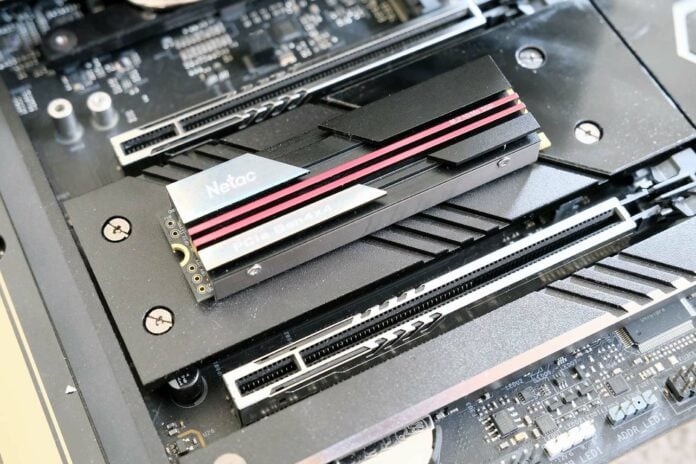There really has never been a better time to invest in solid-state storage for your PC or PlayStation 5. Prices have been tumbling this year as manufacturers trip over themselves to win the grace of enthusiasts worldwide.
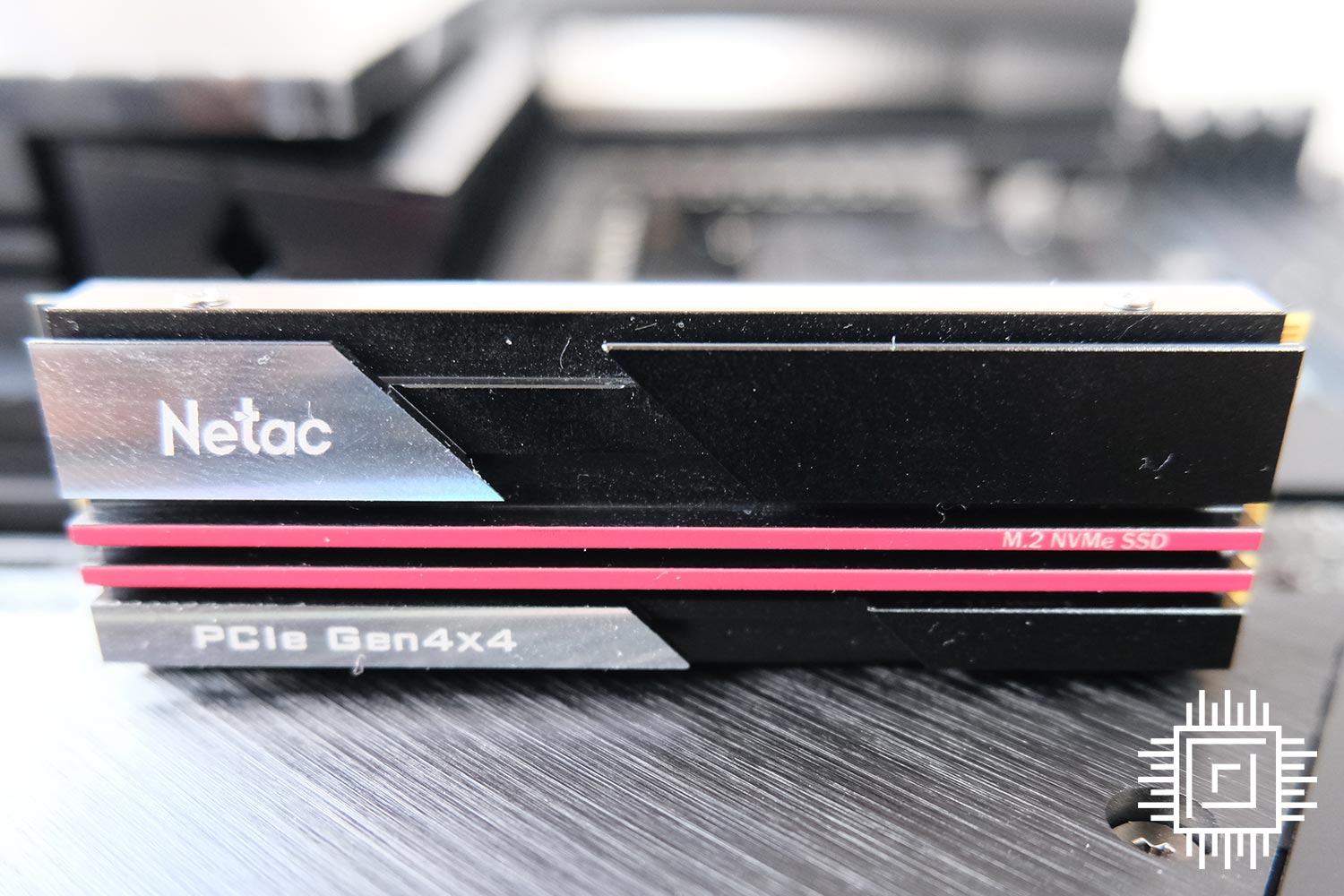

Netac NV7000 2TB
£106
Pros
- Great value
- Solid performance
- Large SLC cache
- Heatsink included
Cons
- Basic utility
Club386 may earn an affiliate commission when you purchase products through links on our site.
How we test and review products.
Once the preserve of high-end systems, PCIe 4.0 x4 SSDs are legion and bargainlicious. Fancy a fast 2TB drive for less than £110? This is exactly what Netac is promising with the NV7000 SSD pre-armed with an aluminium heatsink.
Specifications and Analysis
| Netac NV7000 | 1TB | 2TB | 4TB |
|---|---|---|---|
| Controller | InnoGrit Rainier | InnoGrit Rainier | InnoGrit Rainier |
| NAND | 128L YMTC TLC | 128L YMTC TLC | 128L YMTC TLC |
| DRAM | LPDDR4 | LPDDR4 | LPDDR4 |
| Interface | PCIe 4.0 x4 | PCIe 4.0 x4 | PCIe 4.0 x4 |
| Sequential Read Speed (MBps) | 7,200 | 7,200 | 7,200 |
| Sequential Write Speed (MBps) | 5,500 | 6,800 | 6,850 |
| Random Read IOPS (K) | 460 | 620 | 940 |
| Random Write IOPS (K) | 920 | 900 | 1,000 |
| Form Factor | M.2 | M.2 | M.2 |
| Endurance (TBW) | 700 | 1,400 | 3,000 |
| Hardware encryption | No | No | No |
| Heatsink version | Yes | Yes | Yes |
| Current price | £66 | £106 | £263 |
Perusing the specification table unearths no major revelations, but there is more to this drive than first meets the eye. You see, Netac builds out the NV7000 multiple ways; let me explain. The exact choice of controller and NAND depends on component availability and therefore isn’t, as you might expect, a fixed bill of materials.
Most Netac NV7000 SSDs now feature an InnoGrit Rainier controller and 128-layer TLC NAND from YMTC, as illustrated above, though there are models housing a Phison E18 controller, 176-layer Micron NAND or even 128-layer SK hynix NAND. Point is, you won’t know the exact hardware composition until it arrives. This variable-BOM strategy is what, according to Netac, allows it to keep value very much to the fore.
Netac ensures a baseline level of performance irrespective of the hardware contained within, and we don’t have a problem with that. SSDs work at slightly different speeds depending upon the host system – some are faster on Intel, others favour AMD – so natural variability is to be expected in any case.
Our review sample toes the specification line as laid out in the table above. The InnoGrit Rainier IG5236 is new to us. Built on a 12nm process, the controller uses a quad-core Cortex-R5 chip running at 667MHz and interfacing with eight NAND channels operating at up to 1,200MT/s for increased parallelism. Supporting hardware-baked security inherently, Netac decides against implementing that option, presumably to lower cost and minimise complexity.
Yangtze Memory Technologies (YMTC) is another new name. Formed in 2016 with an initial investment of $24bn, the company is now shipping 232-layer NAND into the market. Netac’s requirements are more modest, opting instead for 128-layer TLC flash. Combined with the controller, there’s enough bandwidth scope to nearly saturate the PCIe 4.0 interface for both reads and writes.
IOPS and endurance don’t set the heart fluttering. The 2TB model, for example, ships with a 1,400TBW, indicating a little less than 1TB writing per day, every day, over the five-year warranty period. That’s okay in general, but pales against the 2,550TBW offered on the Phison E18-powered Seagate FireCuda 530 2TB SSD.
A Right Looker
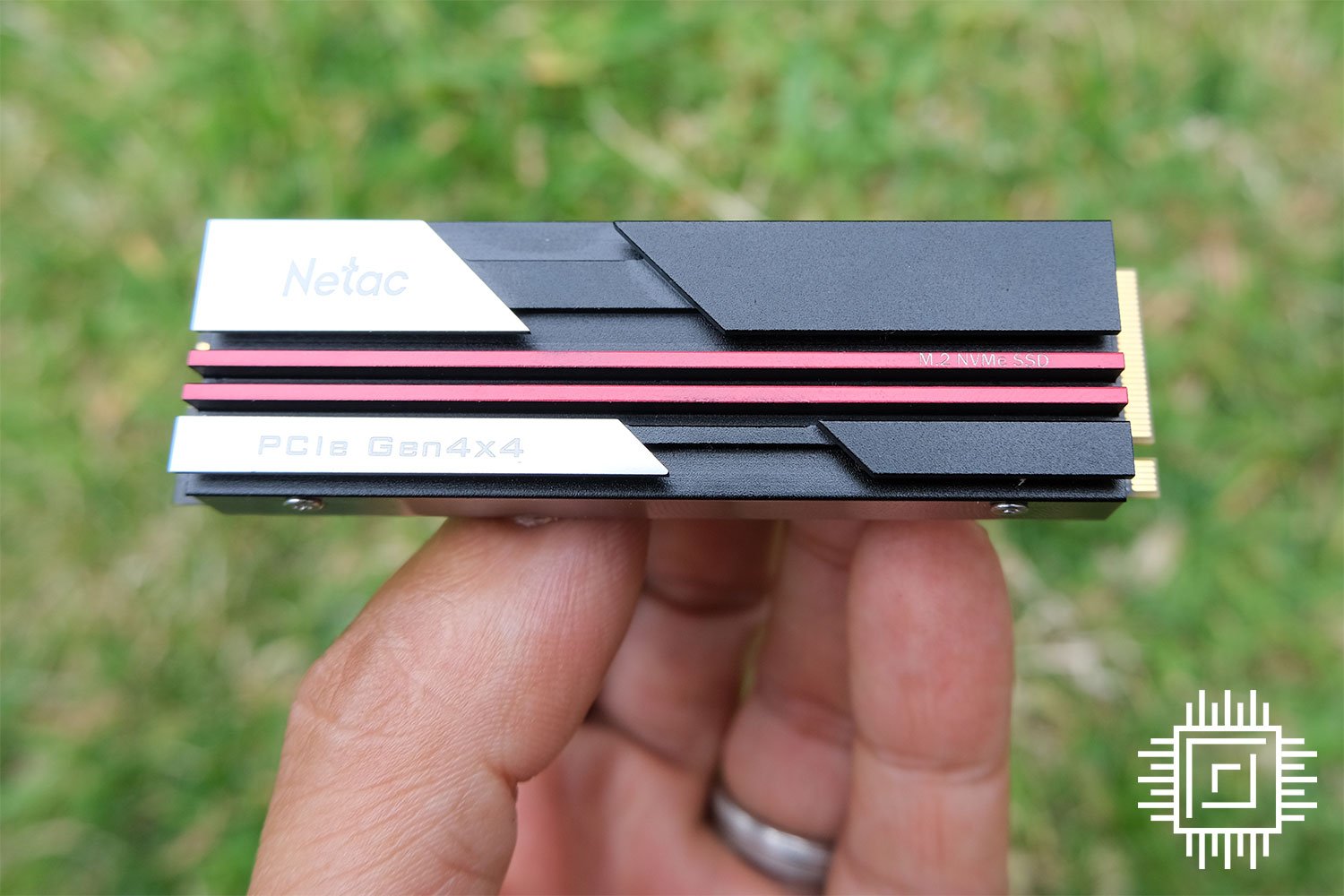
It’s rather fetching as far as SSDs go. Pre-clad with an nice-fitting aluminium heatsink and sitting on a sled, the Netac NV7000 2TB drive’s angles and colours marry up well. The slimline nature is deliberate, as it’s designed to be perfectly at home in a space-constrained PlayStation 5 console, as well as the main storage workhorse in myriad PCs.
Slipping off the cover is a simple act of removing four small Torx screws, but in doing so the five-year warranty is invalidated. Don’t try this at home!

Netac’s 2TB model features the InnoGrit Rainier controller on the left, a 1GB SK hynix DRAM buffering chip in the middle, and two YMTC-produced 512GB modules on the right, identified as NTEF04TY3EL1G9. The latter trio is replicated on the back, and it’s good to see thermal tape used on both sides.
The 4TB version, we would presume, accommodates double-density chips; there is no more free real estate necessary to house four more NAND chips.
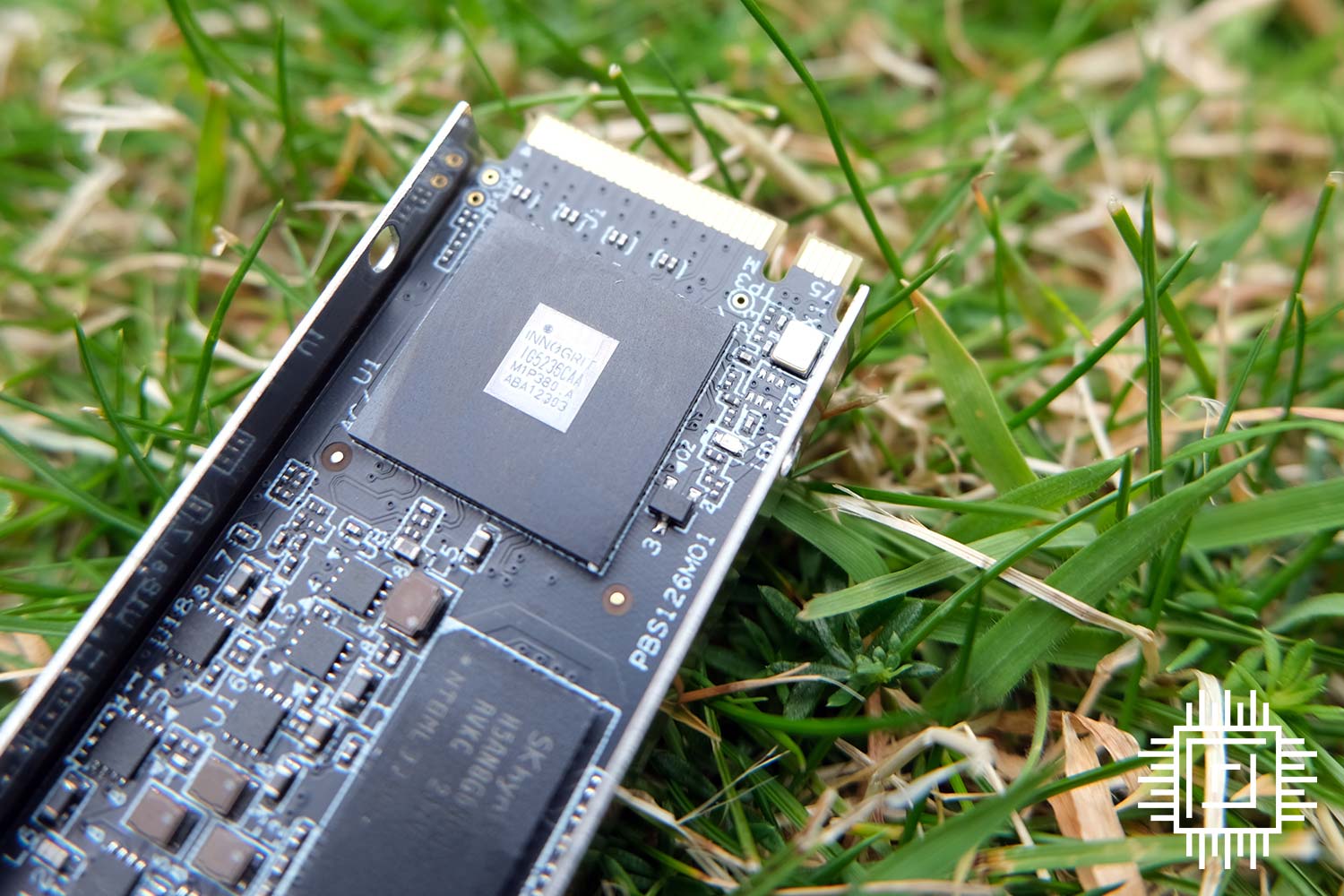
Shimmed up for better heat transfer, the IG5236CAA controller is also present in other SSDs. The Acer Plextor M10P, Adata XPG Sage, and BiWin-branded HP and Acer all feature it on certain models. Being new doesn’t mean InnoGrit lacks industry provenance; the company was founded in 2016 by senior engineering executives from well-regarded Marvell.
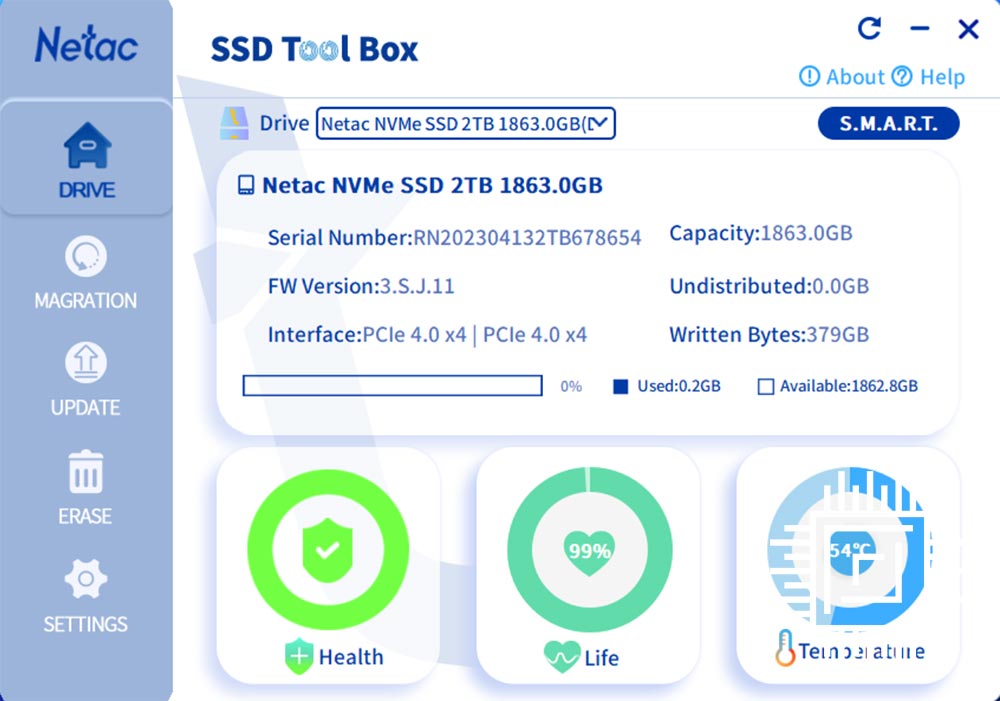
Netac’s supporting utility is basic rather than feature rich. Mind you, it does what it says on the tin, and at the time of testing, no newer firmware was available. Attention to detail is not the strong point; ‘magration’ caused a chuckle or two in the office.
Tested on an ASRock X670E Taichi (1.24 BIOS) and featuring the latest SSD firmwares available, let’s see how competitive NV7000 2TB is against a mob of high-speed solutions.
Transfer speed
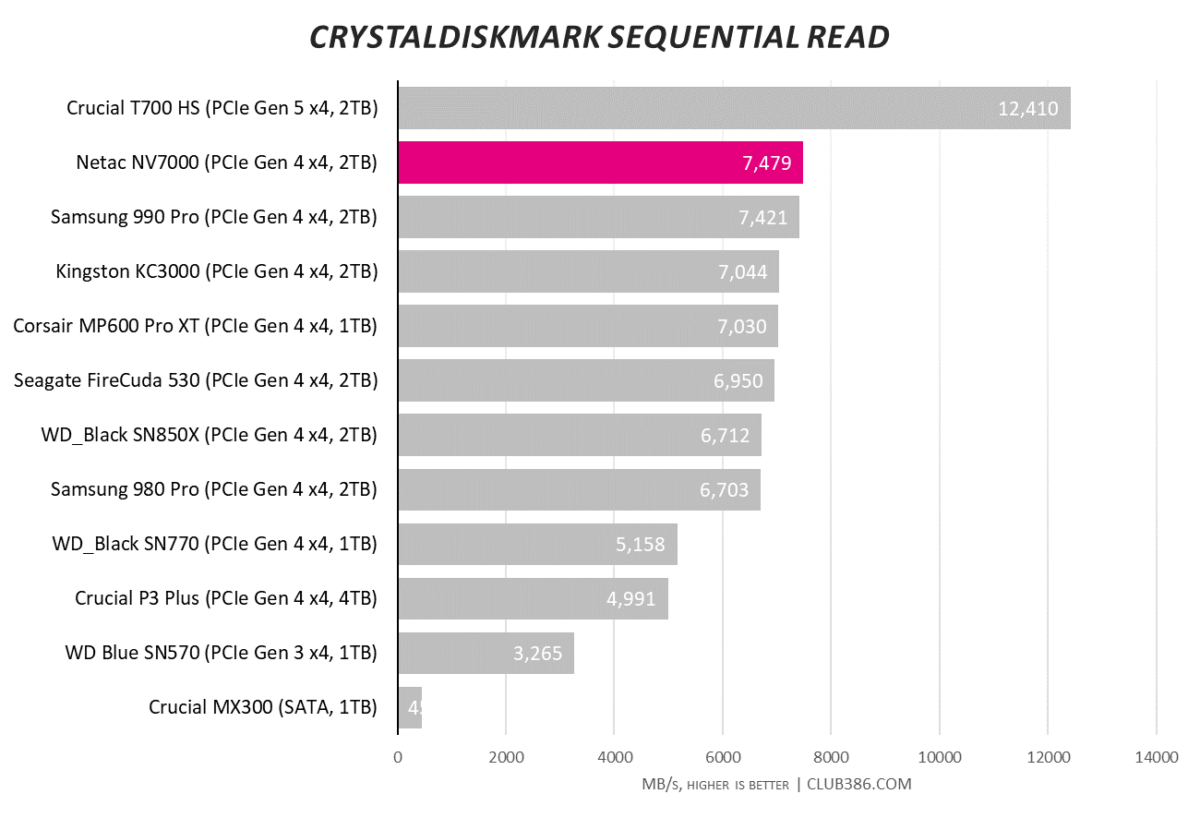
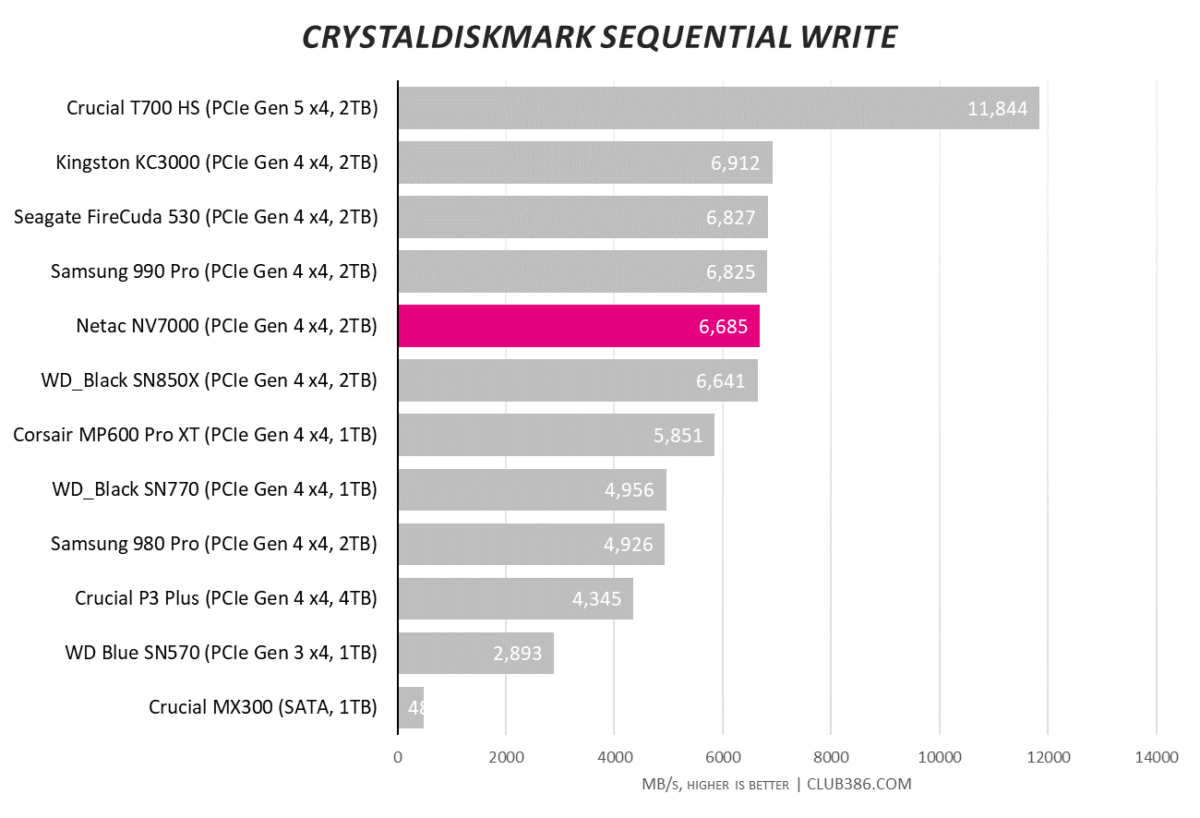
Straight-line speed is impressive enough for what amounts to a budget PCIe 4.0 x4 drive.
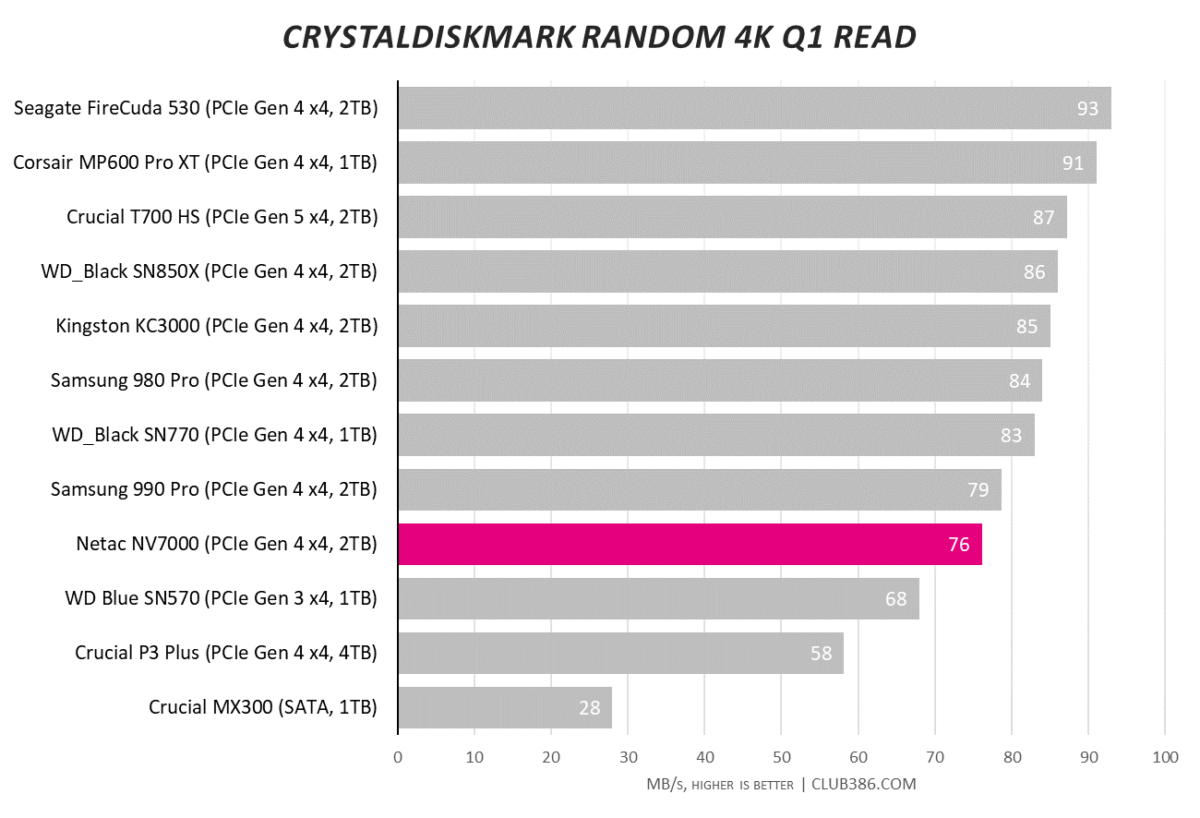
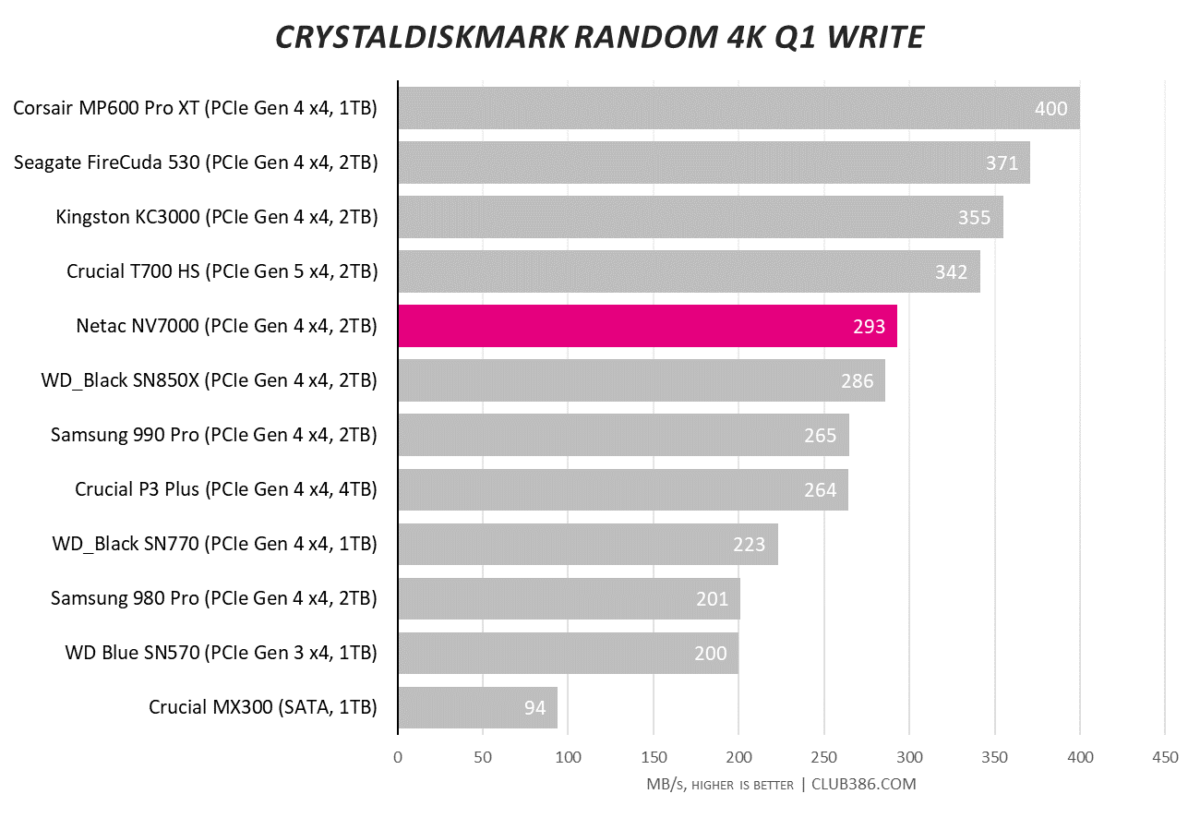
Getting into the nitty gritty by examining performance when dealing with small files, the Netac NV7000 is more okay than brilliant.
Gaming
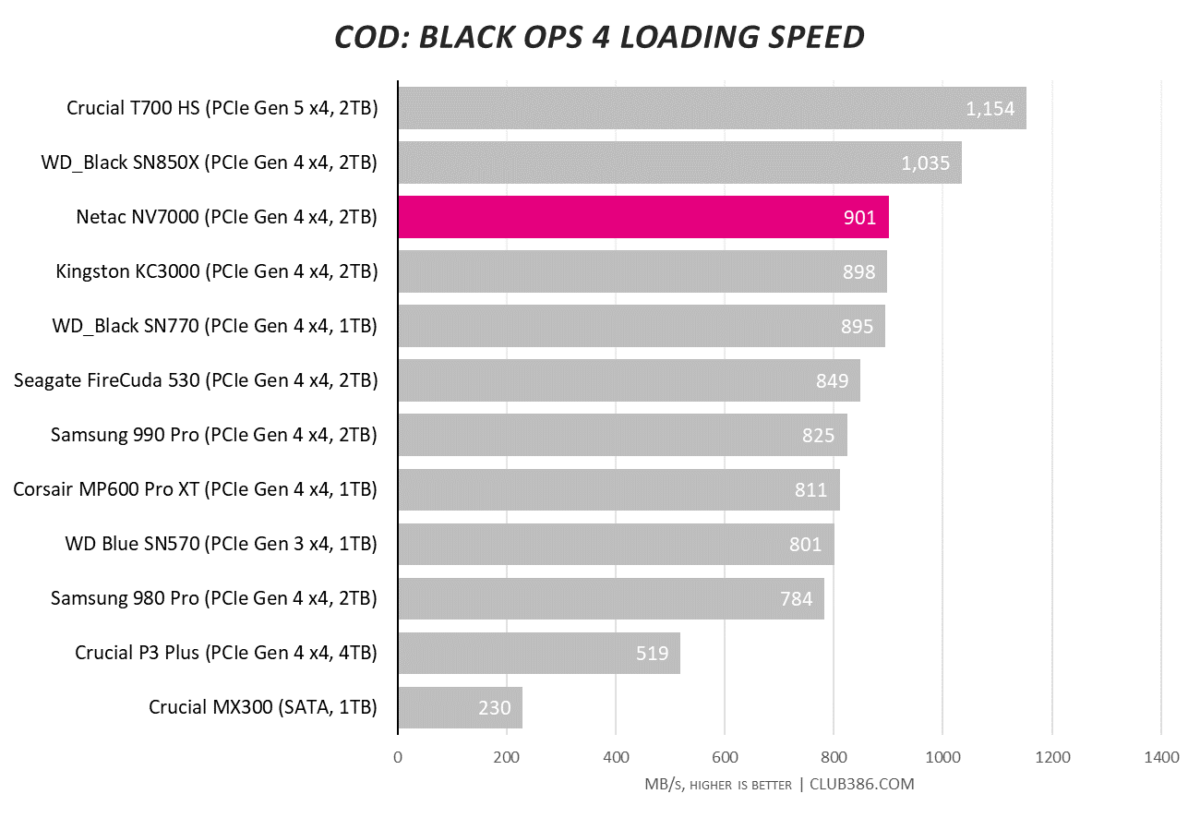
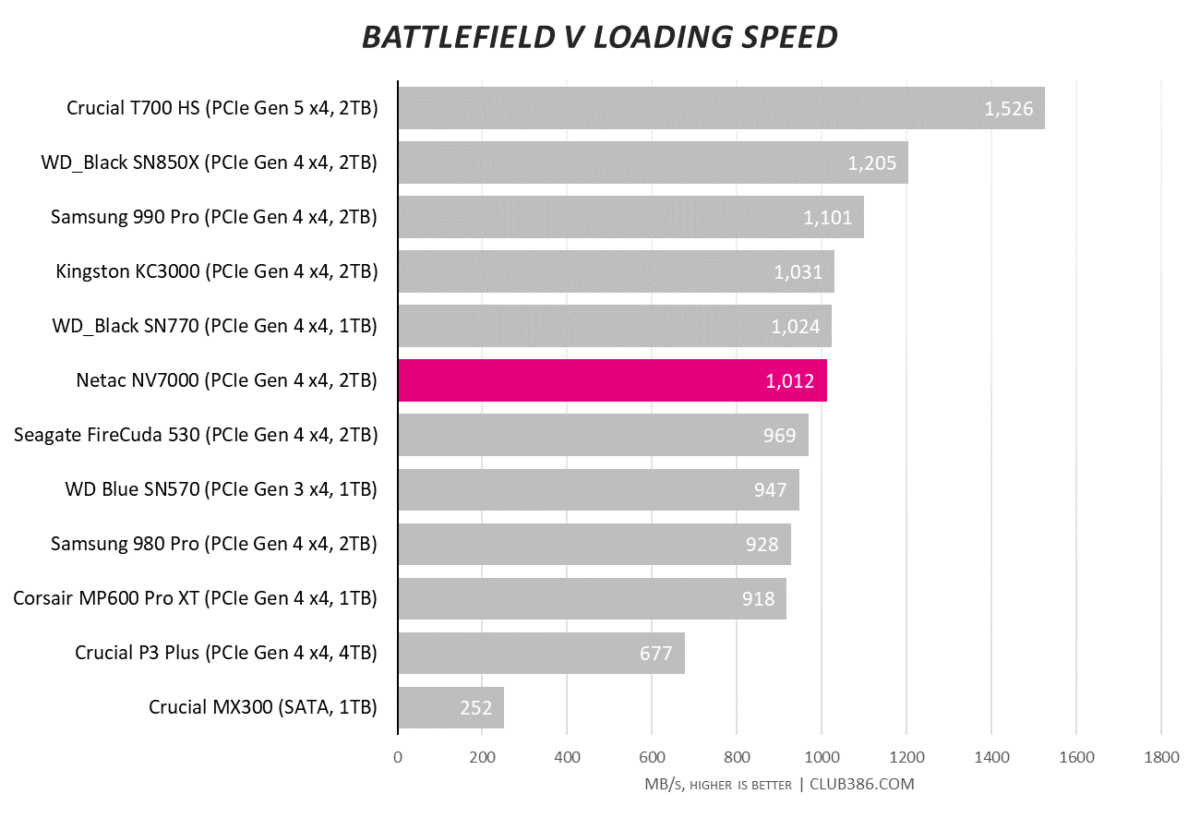
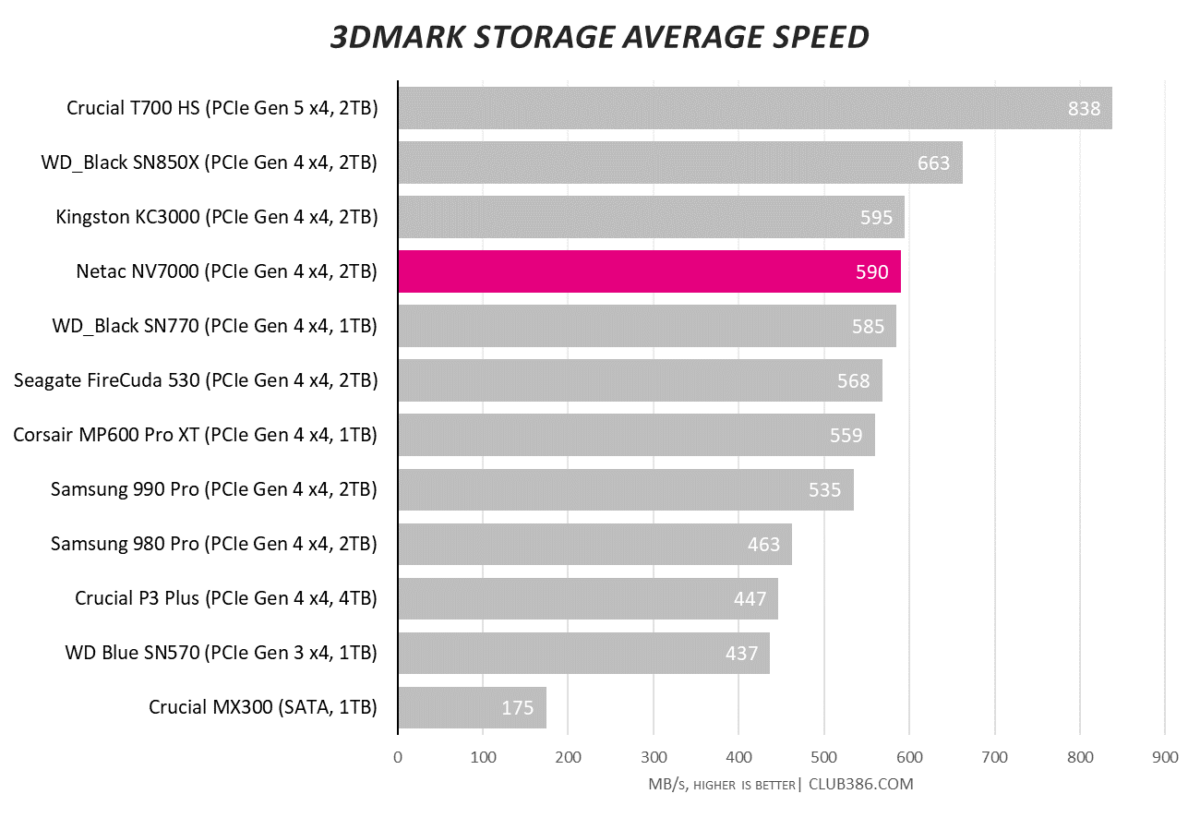
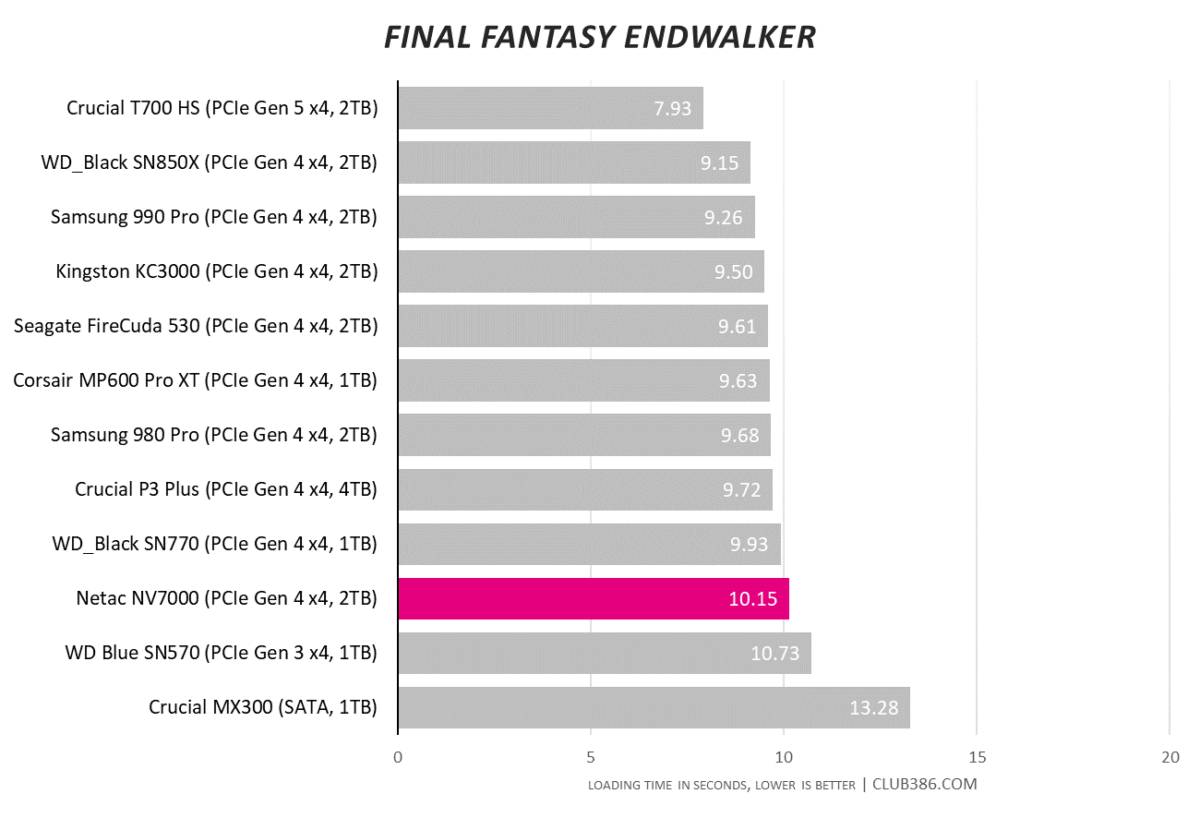
A mixed bag in the gaming tests.
Professional Applications
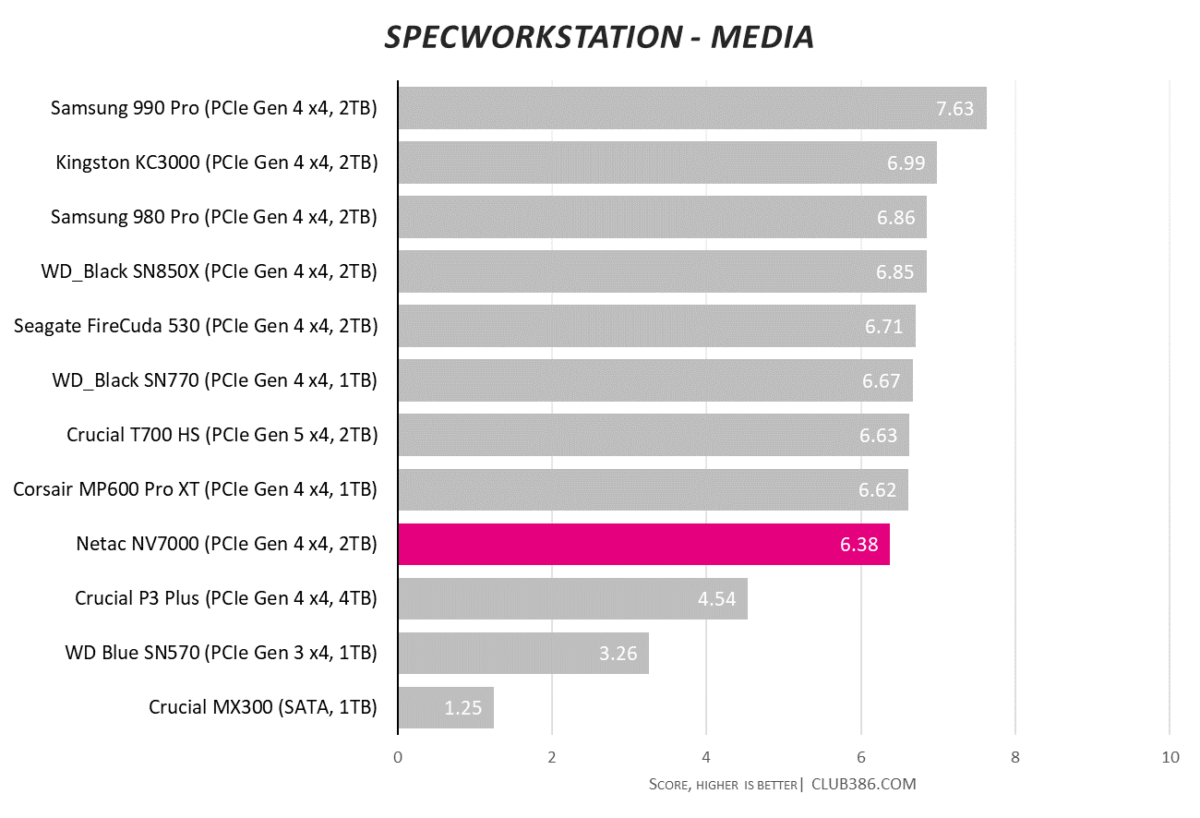
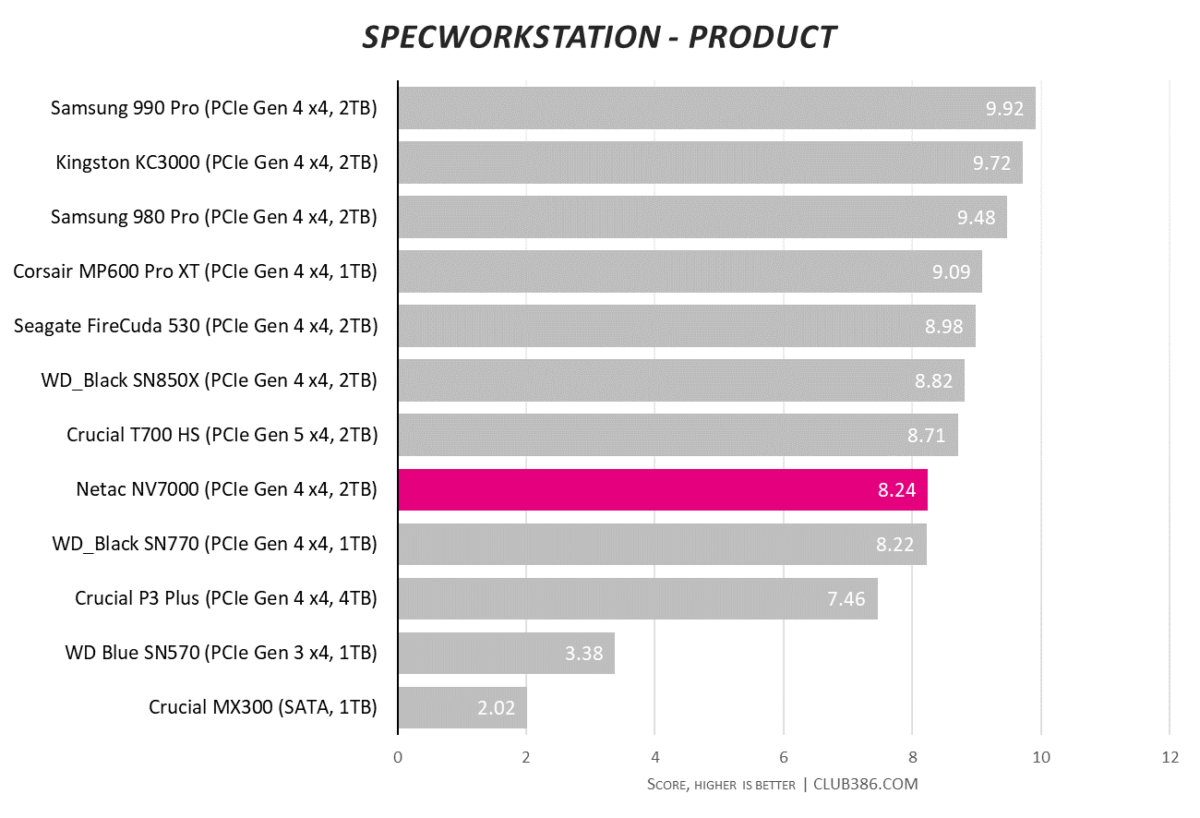
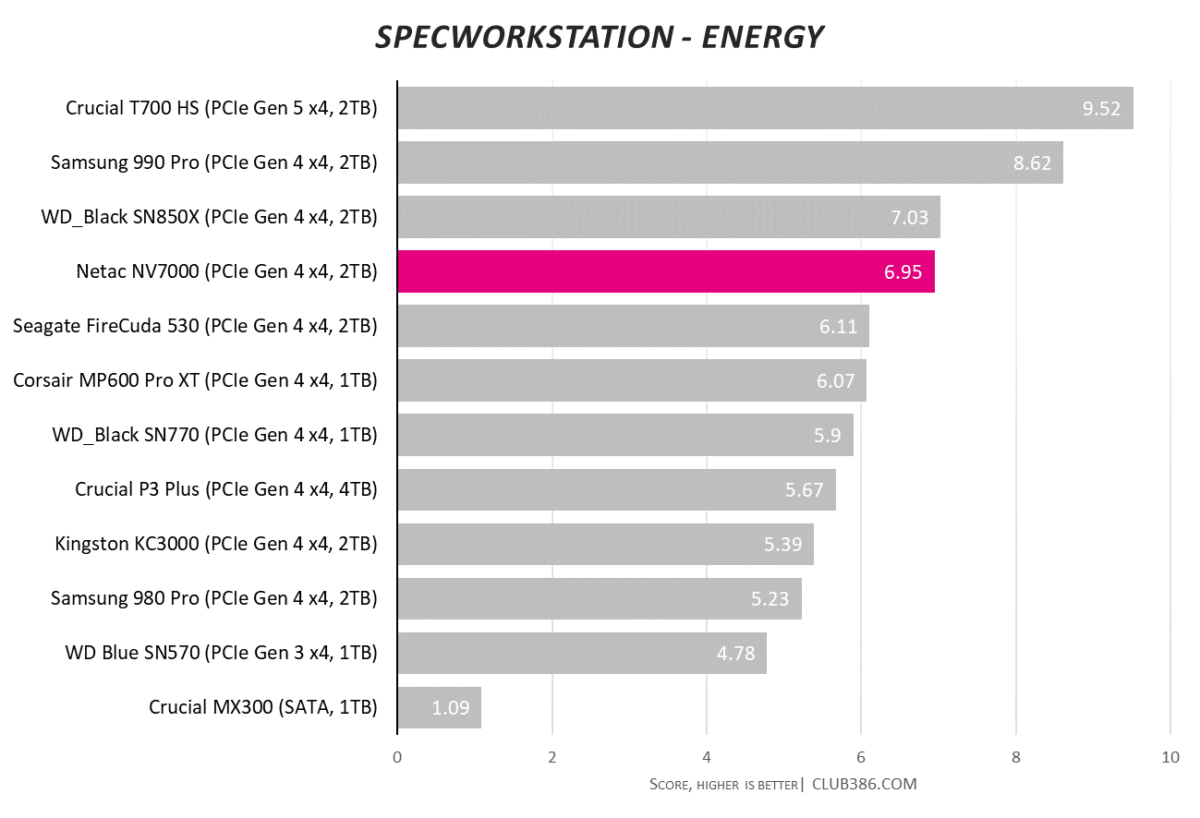
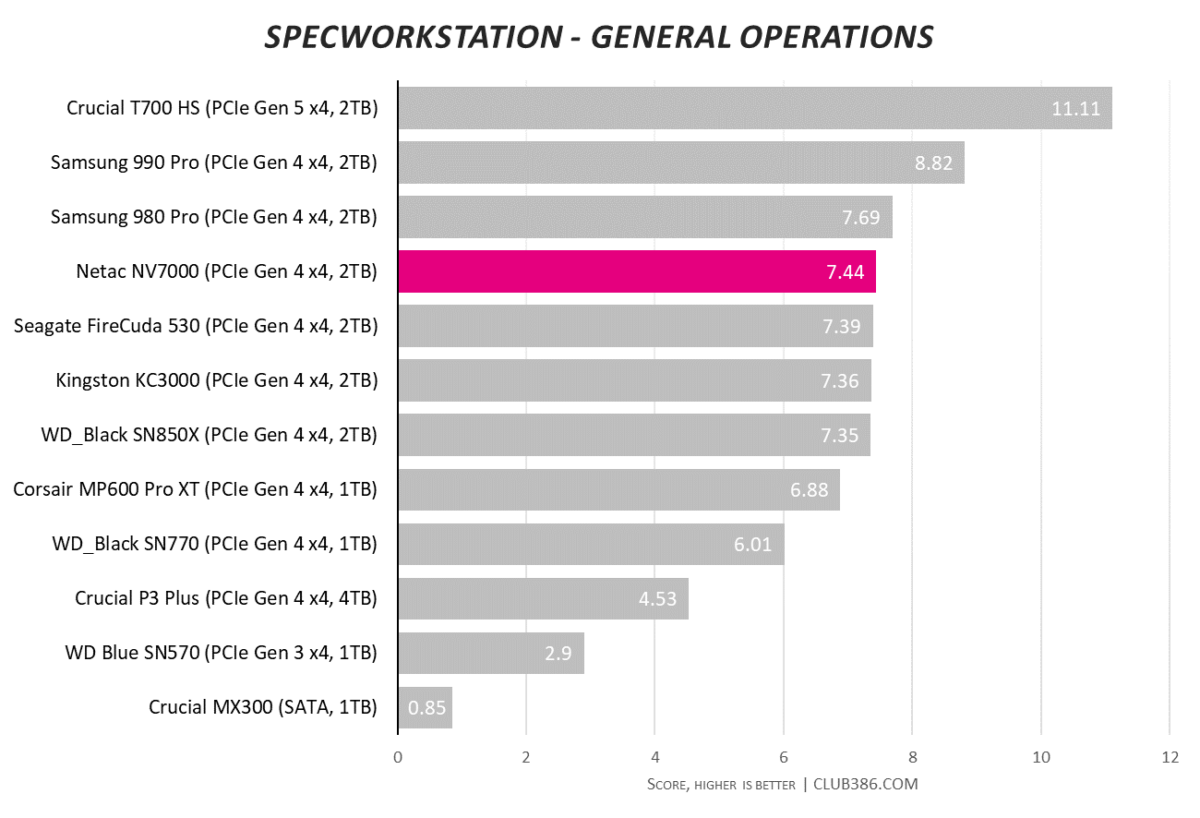
Different controllers handle eclectic load in their own way. The InnoGrit Rainier 5236 plays in the big boys’ playground and isn’t left with the proverbial black eye.
Input/output Operations per Second
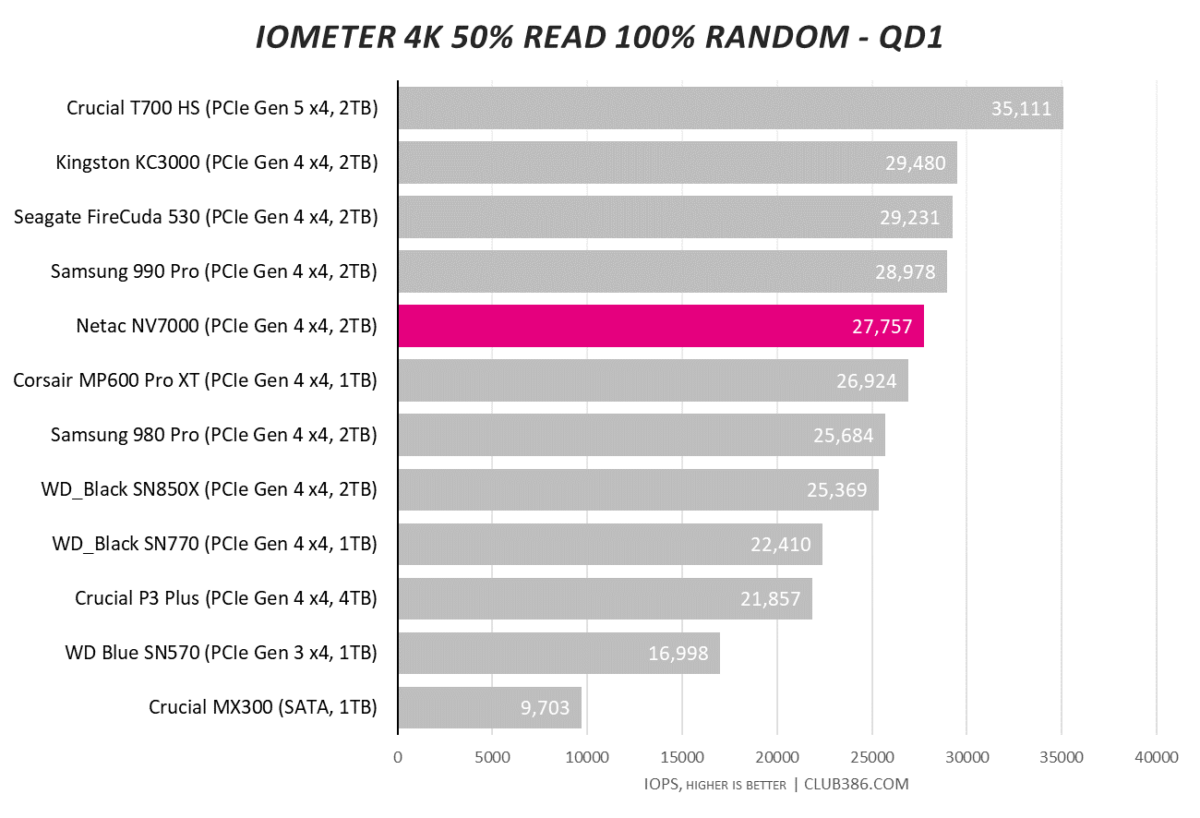
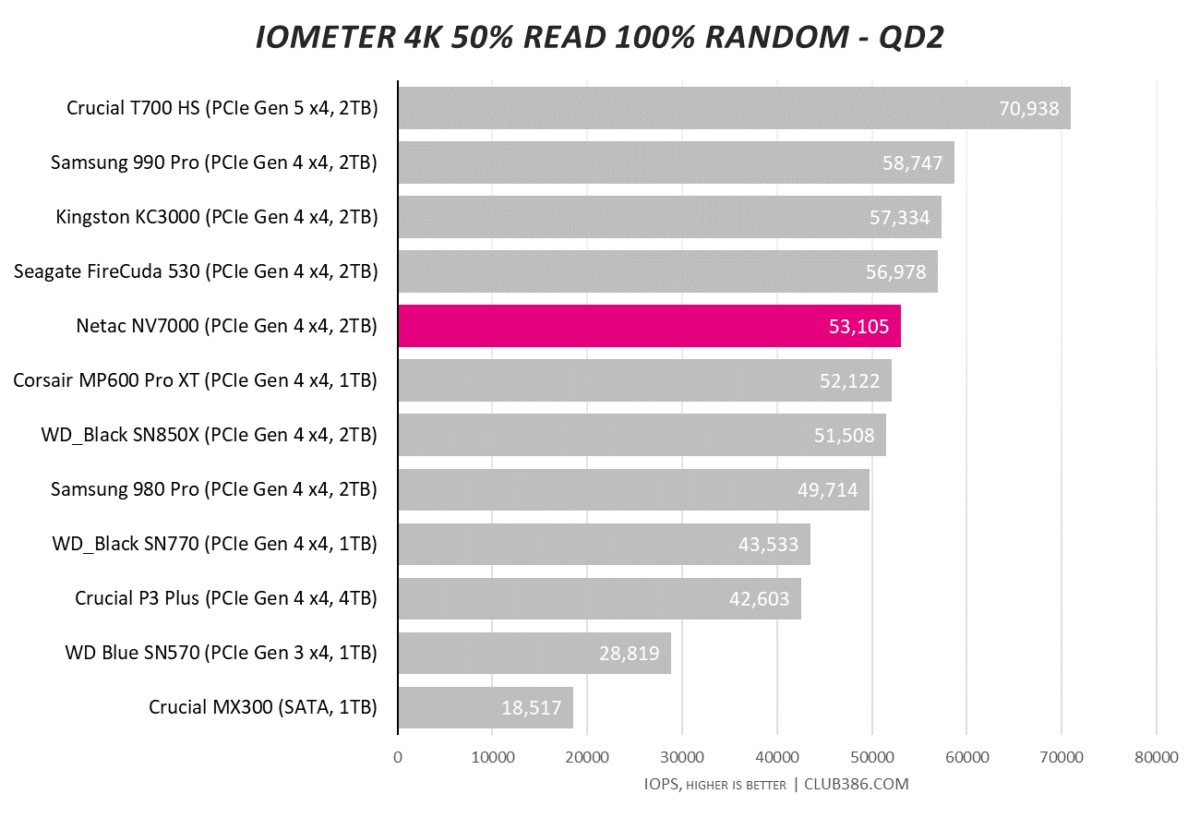
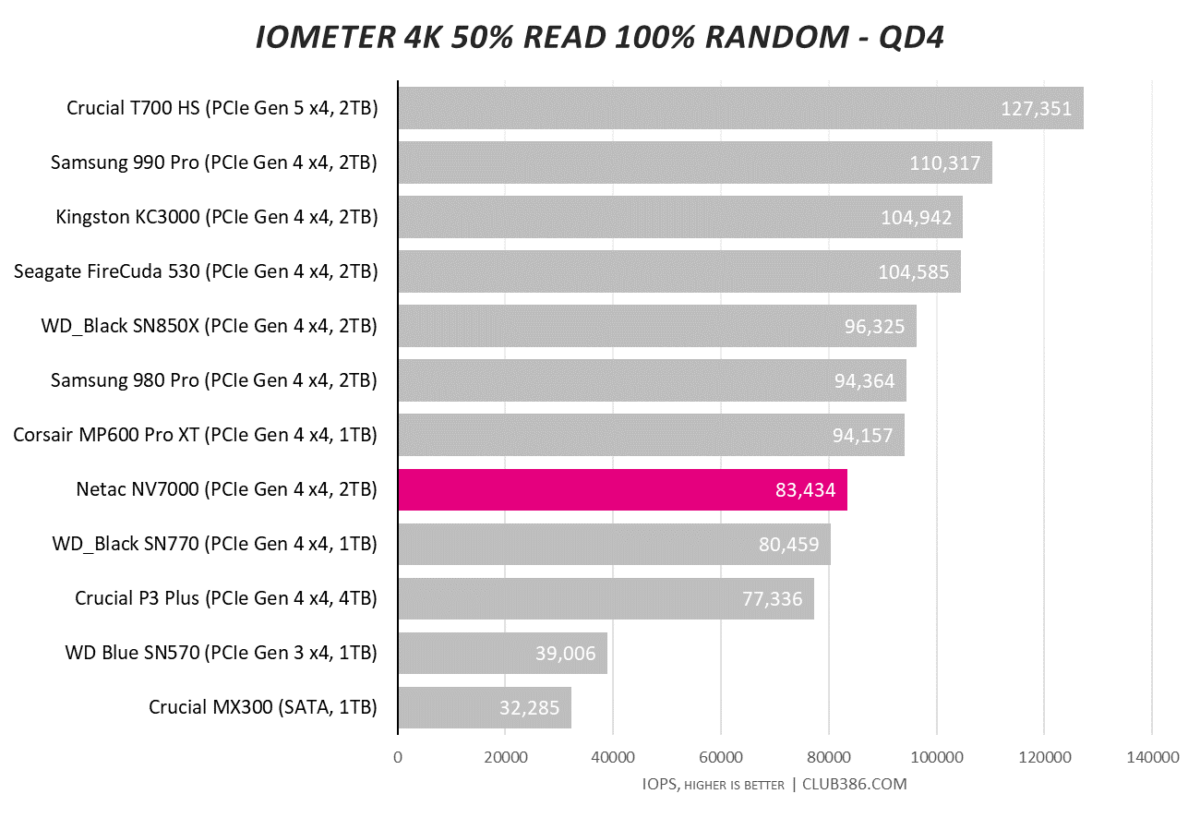
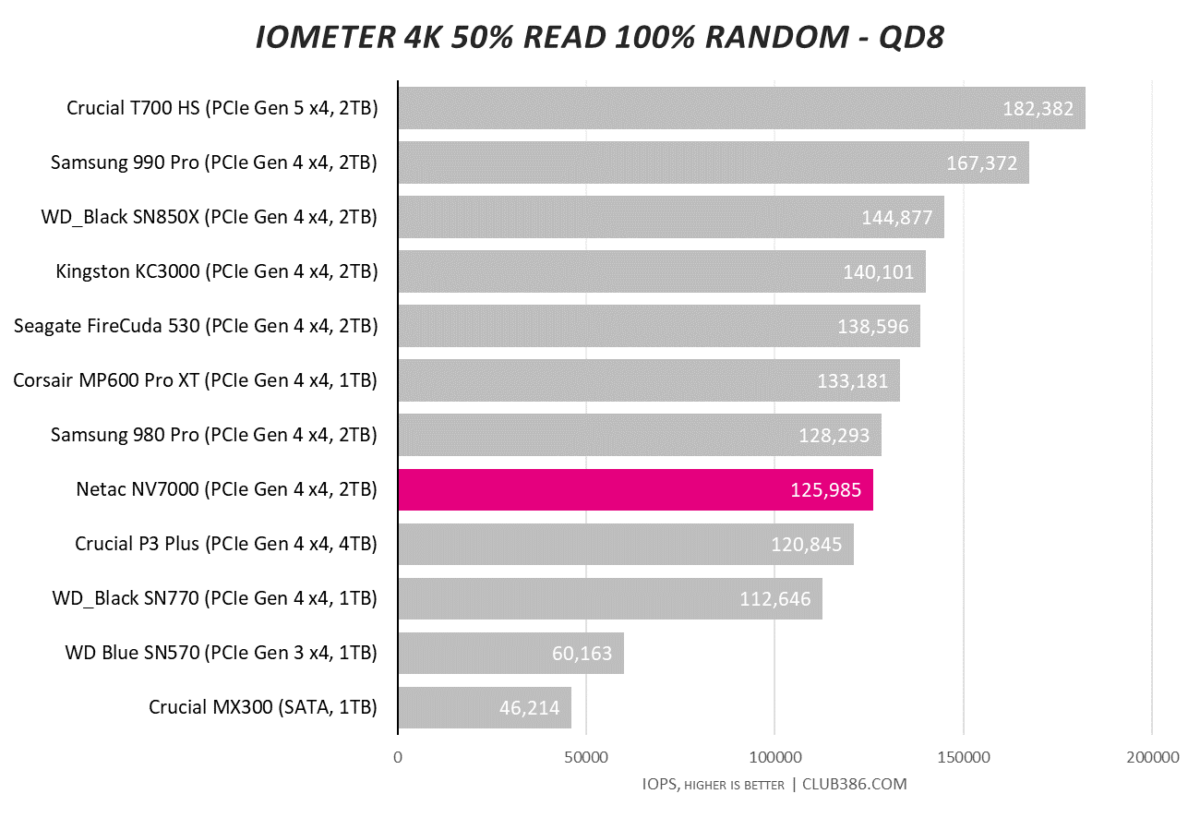
Starting off well, the controller and NAND combination falls of the pace slightly as the worker load is increased.
The company claims one third of the capacity can dynamically be turned into a performance-enhancing SLC cache. We noted a performance drop-off at around the 610GB mark, falling from 5GB/s writes to 2.7GB/s, suggesting the SLC cache is full and generally backing up Netac’s lofty claims. After this time, the write speed loses consistency by flitting between 0.9GB/s and 2.1GB/s. Taken as a whole, SLC caching is excellent.
Extended Testing
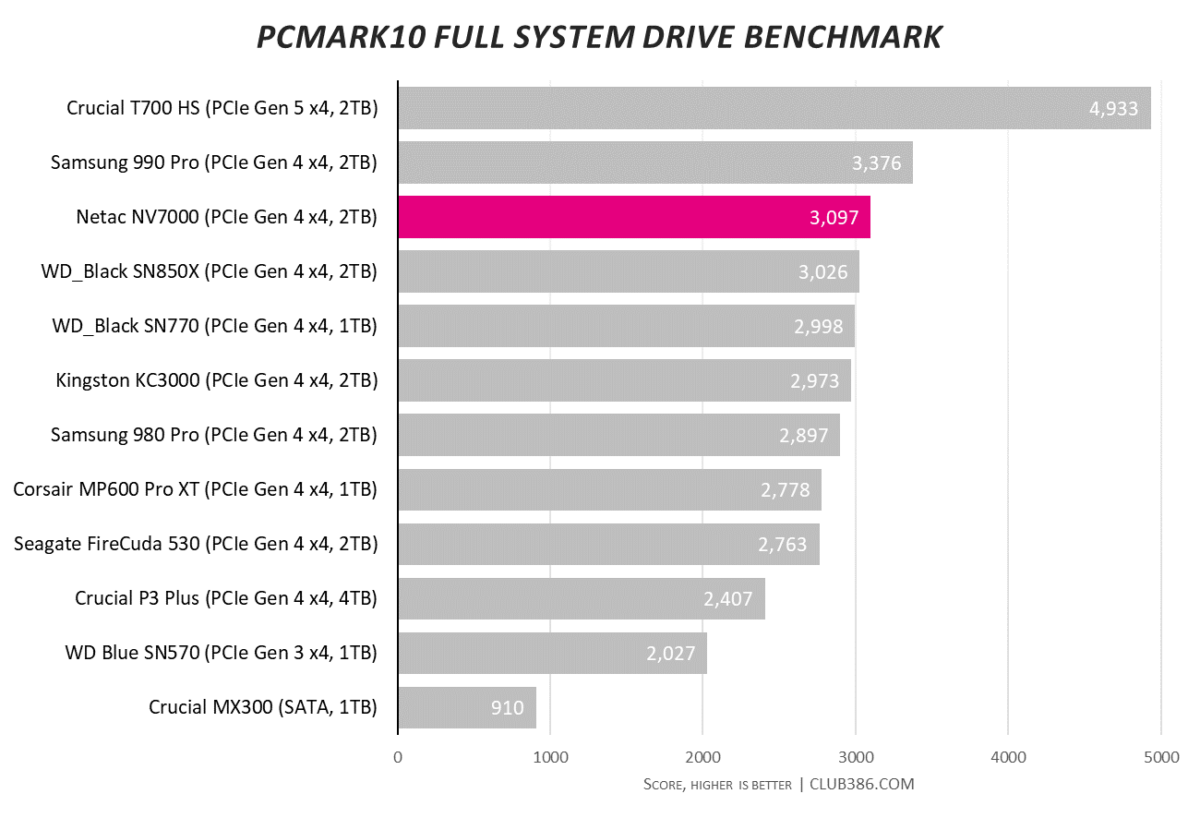
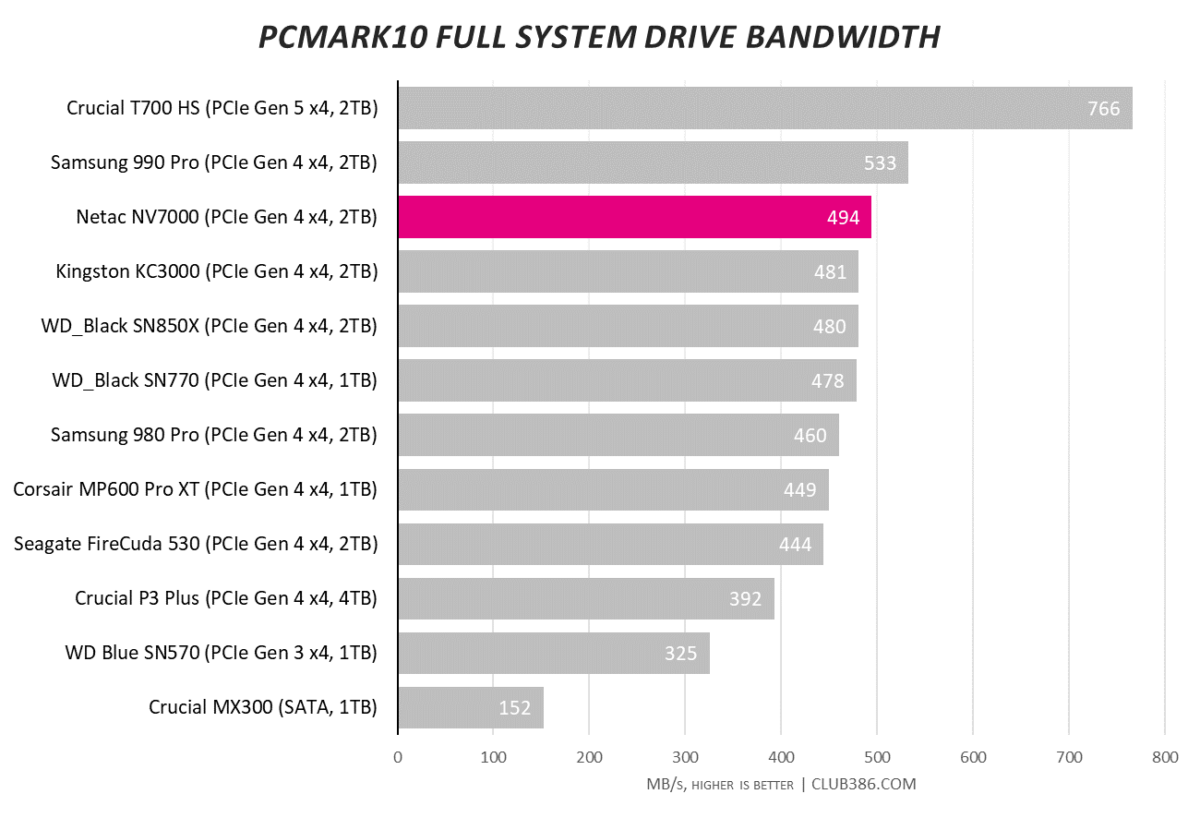
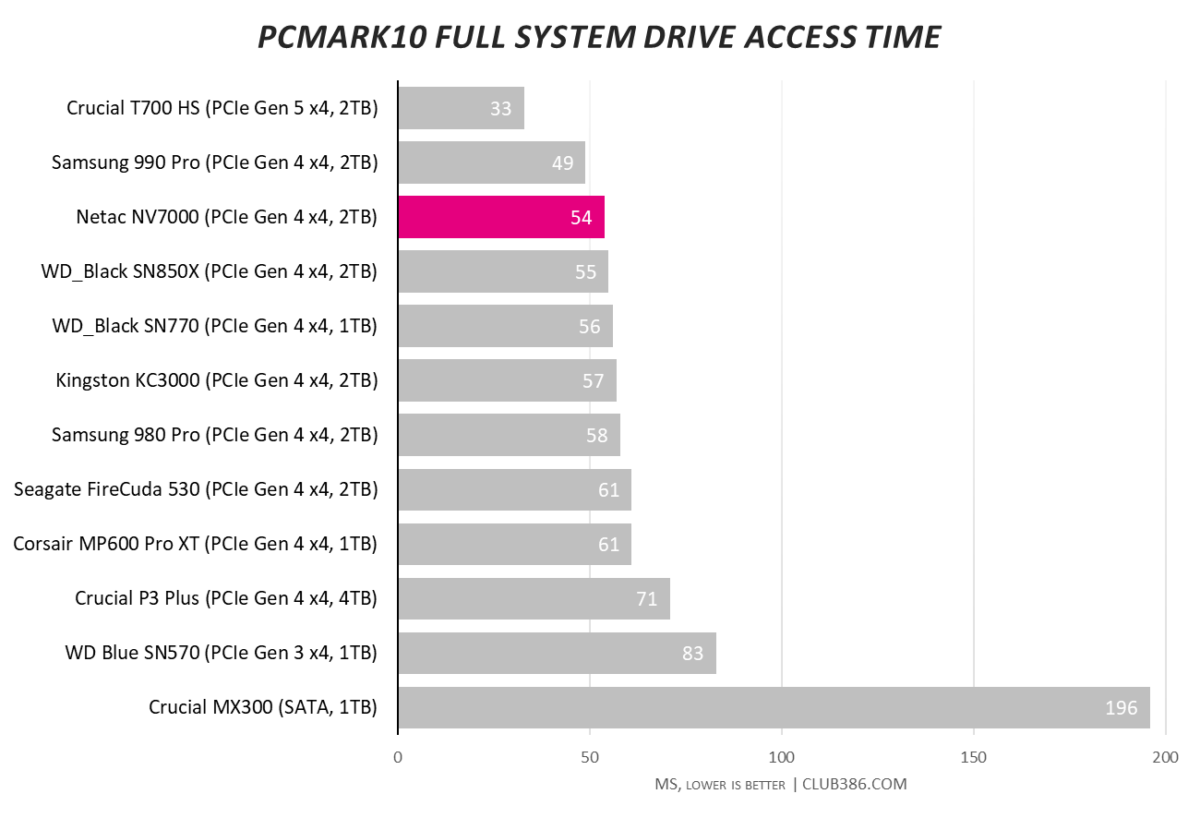
Finishing on a high, we ascertain the Netac NV7000 2TB works best in a standard consumer environment. You’d be hard pushed to tell the performance difference between it and other true enthusiast-class SSDs.
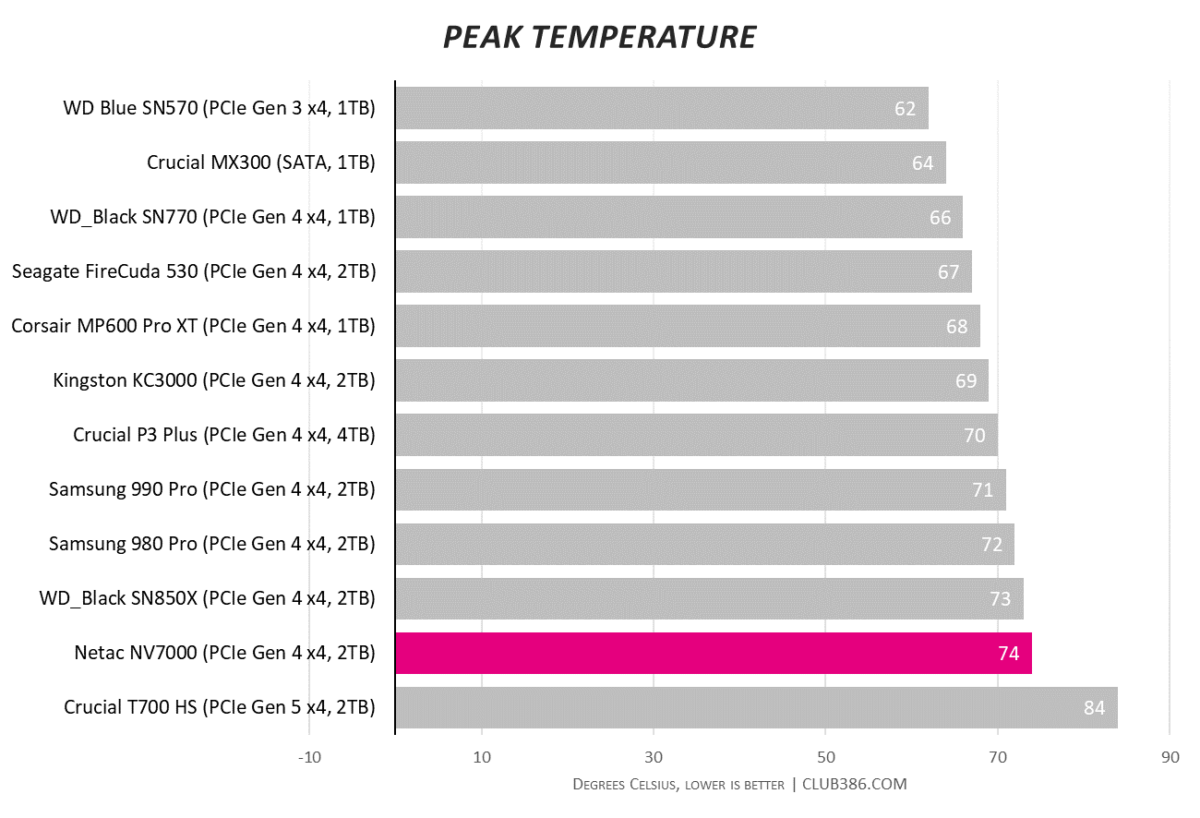
Using a spiffy metal heatsink helps keep temperatures at reasonable levels.
Conclusion
Competition remains key in motivating manufacturers to make better products. Firmly in evidence in the consumer SSD arena, new players are pushing the established guard. Case in point is Netac, whose variable-BOM NV7000 2TB drive provides solid performance at an agreeable fee.
Looking rather lovely in a pretty heatsink and compatible within the confines of a PlayStation 5, Netac provides honest-to-goodness value and choice in a market typically dominated by a handful of players.
Pricing is generally competitive, yet in an effort to stand out from the crowd, limited-time vouchers are commonplace at Amazon. Right now, the 2TB heatsink-clad model is reduced to £106 after 20 per cent off; at this price the NV7000 absolutely deserves to be on a shortlist for a storage upgrade.
Verdict: the name may be new, but the drive offers wholesome performance comparable to established high-profile rivals.


